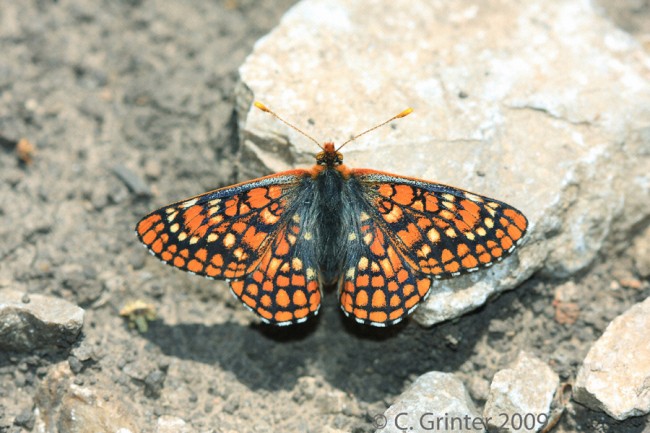Kicsit hanyag voltam a rendszeres kihívások közzétételében, úgyhogy megpróbálom felvenni a tempót. Ki tud nekem valamit mondani erről a pillangóról? A legtöbbet az USA nyugati feléből kapja. Hitel a családnak, nemzetség vagy faj és nevetséges az alfajok beszámítása, és honnan származik.
Euphydryas anicia cloudcrofti
Ted sikerült elég gyorsan azonosítani ezt a leplet lenyűgöző pontossággal egy bogárfiú számára. Neked, akik ezt olvasod, le kell hajtanod a fejed szégyenben, amiért nem ugrasz rá gyorsabban.
Ahogy a megjegyzésekben is említettük, ez a pillangó csak Cloudcroft üdülőváros körül repül, Új-Mexikó a Sacramento-hegységben. Évek óta küzdenek azért, hogy ez a faj a veszélyeztetett fajok közé kerüljön, de minden próbálkozás kudarcot vallott (a legutóbbi elutasítás augusztus volt 2009). A város szinte kizárólag a téli síterepekre támaszkodik, és a fejlesztők sikeresen felvették a harcot a védelem ellen. Az egész terület a Lincoln Nemzeti Erdőben található, de csak lezárták a területet a lepkegyűjtés elől, nem fejlesztés. Az erdészeti szolgálatnál a pillangóról kérdezve egyértelműen kijelentik, hogy a kockás pont veszélyeztetett (bár nem az). Természetesen nem akarják, hogy összegyűjtse – de ha felajánlana néhány milliót élőhelyének fejlesztésére, az egy másik történet.


I’m going with one of the checkerspots – family Nymphalidae, genus Euphydryas. I’m not very good with the species, but with all that orange and very little whitish coloring I’m guessing És. anicia capella from the eastern side of the Rocky Mountains.
Great guess – but not quite. You do get credit for getting the species right though!
Oh, well that wouldn’t be Euphydryas anicia cloudcrofti (Sacramento Mountains checkerspot butterfly) from central New Mexico, would it? Ha így, that’s a great shot of a rare subspecies. Ha nem, well, these checkerspot subspecies are too difficult for me. 🙂
Igen, it is! I should make these harder… or stop posting images I’ve already uploaded to Butterflies of America! van. Bár, kudos for getting this correct, still required digging through the anicia subs, these checkerspots can be a headache to ID.
I was there last summer and got a few great shots of this rare butterfly. It was actually pretty common along forest roads around the town. Within an hour I saw 4-5 puddling – made for a pretty easy photo-op.
Ha! Tulajdonképpen, I didn’t find the photo at BofA until after I’d made my 2nd guess, honest. Those points are mine! Tulajdonképpen, I was using BugGuide when I settled on anicia – I wasn’t sure about it but chose it because of the very orange capella subspecies. When you confirmed anicia it was then easier to search for other subspecies. I came across a photo of cloudcrofti on a FWS conservation plan document and it was a dead ringer.
Finding species/subspecies of highly restricted geographical occurrence is one of the best things about this business (taxonomists arguments about validity notwithstanding)! There must be something special about the Cloudcroft area – there is a buprestid beetle known only from that area that I looked for once (unsuccessfully).